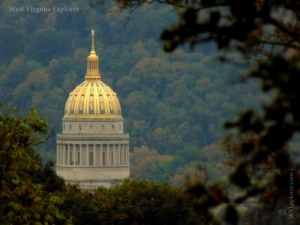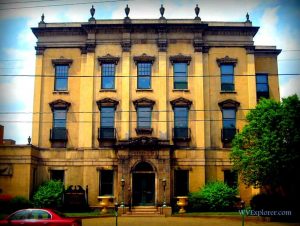
The West Virginia State Capitol is the seat of government for the State of West Virginia and houses the West Virginia Legislature and the offices of the Governor of West Virginia.
Architect Cass Gilbert designed the buff limestone structure that extends outward from a gilded dome more than 292 feet high. Gilbert reused part of the design for the U.S. Supreme Court in Washington, D.C., which includes a larger version of the chamber designed for the West Virginia Capitol's East Wing. Construction began in 1924, and the building was dedicated by Governor William G. Conley on June 20, 1932.

The present capitol building is the fifth raised since West Virginia became a U.S. state. The Legislature first met at the Linsly Military Institute, built in 1859 in Wheeling, West Virginia. Wheeling was then the largest city in West Virginia and a western rival to Richmond, Virginia, long the location of the capitol of the Commonwealth of Virginia.
In 1865, the young West Virginia legislature voted to move the capitol to Charleston, which was to be the permanent capital city, but it remained in Wheeling until 1870, when the new capitol was completed.
In 1869, construction began on a new building on Capitol Street in Charleston designed by Cincinnati, Ohio, architect Leroy S. Buffington, of Anderson & Hannaford, combining elements of the Italianate, Second Empire, and Victorian Gothic styles. The legislature met in the building until 1875, when Wheeling offered to build a new capitol, if the Legislature would agree to return to the city. This choice was fueled by the greater accessibility, as Charleston did not then have rail access.
The Legislature was transferred back to Wheeling in 1875, and met in the Linsly building until the new building was completed in 1876. Designed by Joseph S. Fairfax, the new capitol was a very large Second Empire building. The next year, a statewide election was held to determine a permanent capitol, but due to statewide anti-Wheeling sentiment, the city was not even a choice. Charleston was selected, and in the fall of 1877, Governor Jacob issued a proclamation that after 1885, that city would be the permanent state capital
After the Charleston building was completed in 1885, the Wheeling building was remodeled by architect Charles P. Hamilton to serve as city hall and county courthouse. It survived until 1959, when a new building went up on the same site.
Construction on the second Charleston capitol, designed by Pittsburgh architect Andrew Peebles, commenced in 1880, during which time the 1870 capitol was almost completely destroyed. Kemble was relieved from his duties in 1884, and Stanton M. Howard, of Wheeling, completed the building in 1885. The new capitol was a picturesque Victorian Gothic building, which stood until it was gutted by a fire in 1921.
A temporary wooden capitol, derisively referred to as the "pasteboard capitol," was raised by the state in 1921 on Washington Street near the old capitol site, with the expectation that the new building would be built at the old site. However, a new riverside location in the eastern end of the city was chosen. The temporary capitol was destroyed in a 1927 fire while the present capitol was being built.
The present West Virginia Capitol is renowned for its picturesque location along the Kanawha River. Its front faces the river and Kanawha Boulevard. Two wings extend perpendicular to the east and west of the building, forming an open-ended quadrangle centered on a fountain. The two wings are connected by low causeways on the basement level. The Governor's mansion and buildings housing a cultural center and several state departments overlook the plaza.
The grounds include several famous statues, including that Abraham Lincoln, known as Abraham Lincoln Walks at Midnight, by Fred Torrey, which depicts a stately and thoughtful Lincoln, who was in office at the time of the state's incorporation, walking, head bowed, wearing a robe over his clothes, facing the river. Holly Grove Mansion and the West Virginia Governor's Mansion are also located at the complex.
The West Virginia capitol is featured in the Fallout 76 video game.




